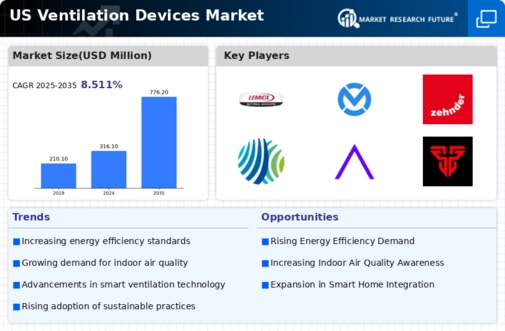Regulatory Compliance and Standards
The ventilation devices market is increasingly influenced by stringent regulatory compliance and standards set by government agencies. These regulations aim to ensure indoor air quality and energy efficiency in residential and commercial buildings. For instance, the U.S. Environmental Protection Agency (EPA) has established guidelines that necessitate the use of efficient ventilation systems to mitigate indoor air pollutants. As a result, manufacturers are compelled to innovate and develop products that meet these standards, thereby driving growth in the ventilation devices market. The market for ventilation devices is projected to reach approximately $10 billion by 2026, reflecting a compound annual growth rate (CAGR) of around 5%. This regulatory landscape not only enhances consumer safety but also propels technological advancements within the industry.
Increased Awareness of Indoor Air Quality
Growing awareness of indoor air quality (IAQ) issues is a pivotal driver for the ventilation devices market. Consumers are becoming more informed about the health implications of poor IAQ, which can lead to respiratory problems and other health issues. This heightened awareness is prompting both residential and commercial sectors to invest in effective ventilation solutions. According to recent studies, approximately 50% of U.S. households are now prioritizing air quality improvements, leading to increased demand for advanced ventilation systems. The market is projected to expand as consumers seek products that not only ventilate but also purify air, indicating a shift towards multifunctional devices. This trend underscores the importance of addressing health concerns through improved ventilation, thereby driving market growth.
Rising Construction and Renovation Activities
The ventilation devices market is significantly impacted by the rising construction and renovation activities across the United States. As urbanization continues to accelerate, there is a growing demand for new residential and commercial buildings, which necessitates the installation of efficient ventilation systems. Additionally, renovation projects often require upgrades to existing ventilation solutions to meet modern standards of energy efficiency and air quality. The U.S. construction industry is projected to grow at a CAGR of 4% through 2028, which bodes well for the ventilation devices market. This growth is likely to create opportunities for manufacturers to supply innovative products that cater to the evolving needs of builders and homeowners alike.
Technological Advancements in Ventilation Systems
The ventilation devices market is witnessing a surge in technological advancements that enhance system efficiency and user experience. Innovations such as smart sensors, automated controls, and energy recovery ventilators are becoming increasingly prevalent. These technologies allow for real-time monitoring and adjustment of indoor air quality, which is particularly appealing to consumers seeking energy-efficient solutions. The integration of Internet of Things (IoT) capabilities into ventilation systems is also gaining traction, enabling remote management and optimization. As a result, the market is expected to grow significantly, with estimates suggesting a valuation of $12 billion by 2027. This trend indicates a shift towards more sophisticated and user-friendly ventilation solutions, which could reshape consumer expectations and industry standards.
Shift Towards Energy Efficiency and Sustainability
The ventilation devices market is experiencing a notable shift towards energy efficiency and sustainability, driven by both consumer preferences and regulatory mandates. As energy costs rise, consumers are increasingly seeking ventilation solutions that minimize energy consumption while maintaining optimal indoor air quality. This trend is further supported by government incentives for energy-efficient products, which encourage the adoption of advanced ventilation technologies. The market for energy-efficient ventilation devices is expected to grow by approximately 6% annually, reflecting a broader commitment to sustainability within the industry. Manufacturers are responding by developing products that not only comply with energy standards but also appeal to environmentally conscious consumers, thereby enhancing their market position.




















Leave a Comment